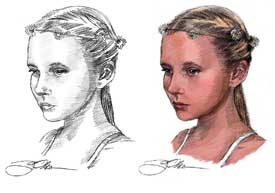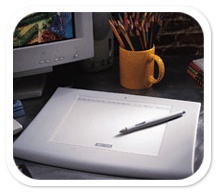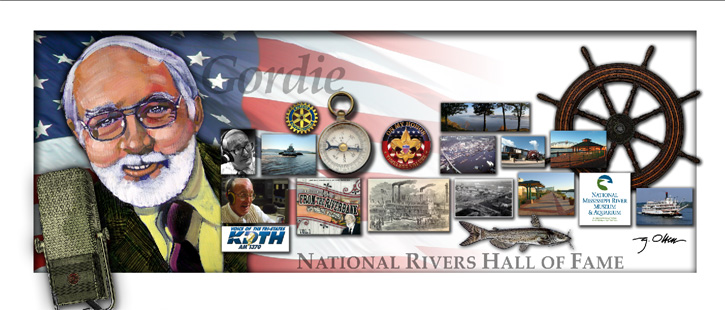
 emories
of a Lifetime represent an interesting variation on the portrait. It becomes
a collaborative process with photos, three-dimensional objects, and whatever
is appropriate to evoke "memories of a lifetime." Gary Olsen
has become quite expert at composing these often epic pictures, some of
which can measure up to 10 feet in length. Most, however, are 22 to 44
inches. All
incorporate original portraiture prepared by Gary, and then it's combined
with other objects digitally captured. No harm comes to any of the precious
heirlooms, photos and objects used to complete the piece. Because the
image is reproduced with precision and care, the objects look absolutely
real and three dimensional. Further, several copies of the original print
can be prepared and presented to other family members. How often do family
members contribute to a gift for parents celebrating an anniversary, receive
a copy of the gift for their own families?
emories
of a Lifetime represent an interesting variation on the portrait. It becomes
a collaborative process with photos, three-dimensional objects, and whatever
is appropriate to evoke "memories of a lifetime." Gary Olsen
has become quite expert at composing these often epic pictures, some of
which can measure up to 10 feet in length. Most, however, are 22 to 44
inches. All
incorporate original portraiture prepared by Gary, and then it's combined
with other objects digitally captured. No harm comes to any of the precious
heirlooms, photos and objects used to complete the piece. Because the
image is reproduced with precision and care, the objects look absolutely
real and three dimensional. Further, several copies of the original print
can be prepared and presented to other family members. How often do family
members contribute to a gift for parents celebrating an anniversary, receive
a copy of the gift for their own families?
Incidentally, if you are interested in seeing the 10 foot mural Gary did for a local beverage distributor, click here.
Works in Process
"This is an opportunity for clients to see works in process without having to visit my studio. This page frequently changes, and once a piece has been approved and delivered, it is moved to our gallery of collected works."
![]()
My good friend Paul Hemmer, a broadcast icon in Dubuque, my home town. I was commissioned to do his retirement gift. I also contributed to this magazine cover celebrating this event.


This doesn't involve a portrait but rather just collected pieces to form a montage. Each banner was printed separately and was 3 feet wide by 7 feet tall. Each had its own stand and could be easily moved and deployed. It doubled as a promotional display and a set piece for a choral concert.
 |
I prepared this piece for my wife's parents' 60th Anniversary. I had a treasure trove of photos, and naturally I have an intimate knowledge of the family's history. The term less is more does not apply here. I believe more is more... more better. Sometimes a density of overlapping images creates a textural effect. I love the three-dimensional pieces, the tomato, apple, corn and fish. The teddy bear was a fabulous find. I'm going full color on the portraits now. It's worth doing, and it unifies everything. I had excellent photographs to work from.
This is a work in process of a memorial piece I'm doing for Prescott Early Childhood Center. This my first attempt at a full color sketch of the subject, Mrs. Mildred Fischer. So far, I like it a lot. Besides the portrait, I really enjoy the images of the kids in the background. These are kids I photographed at Prescott during a fire drill. What a nice way to pass the time out on the sidewalk. Such lovely faces. The other objects were from Mrs. Fischer's old classroom, including an antique pencil sharpener and a cast iron coat hook (lower right). And look at that old globe! The finishing touch is an original poem by Mrs. Fischer in the upper right hand corner.
I don't limit my subjects to people, obviously. This is my friend's favorite hunting dog, Baron.
This piece hangs in the National Rivers Hall of Fame at the National Mississippi River Museum & Aquarium in Dubuque, IA. It is one of two peices I have on permanent display at this wonderful facility. To learn more about the Gordon Kilgore piece above, click here.
The Steps I take to Developing a Portrait Project
 Once
I've worked out all of the details on paper (yes, I use a pencil and paper
up to a point), I scan the sketch for the color work. Using Adobe PhotoShop,
I "float" the scanned image on its own layer as if it were on
a transparency. Then, with a Wacom Tablet The Wacom Tablet is a pressure
sensitive pad and pen that emulates any drawing, painting, charcoal, and
pastel medium that exists, with 500 levels of sensitivity, I paint the
portraits without disturbing my drawing.
Once
I've worked out all of the details on paper (yes, I use a pencil and paper
up to a point), I scan the sketch for the color work. Using Adobe PhotoShop,
I "float" the scanned image on its own layer as if it were on
a transparency. Then, with a Wacom Tablet The Wacom Tablet is a pressure
sensitive pad and pen that emulates any drawing, painting, charcoal, and
pastel medium that exists, with 500 levels of sensitivity, I paint the
portraits without disturbing my drawing.
I helped market the first Wacom Tablet in America back in the late 1980s, demonstrating it at trade shows throughout the country, and I own four of them. They are the standard among special effects film makers and all manner of digital artists, for example,
 The
stylus is ergonomically adaptable for drawing and painting techniques.
It even contains an eraser on the top. Though I still like to draw with
a pencil or pen on paper, I enjoy painting more with the Wacom because
I can make changes as I go. It's like paint that never dries. If the painting
isn't going well, I merely go back in the History Menu in PhotoShop, and
start over. And, there's no cleanup. If Michaelangelo or Rembrandt were
alive today, they would be using a Wacom. In fact, Davinci would have
probably improved upon it.
The
stylus is ergonomically adaptable for drawing and painting techniques.
It even contains an eraser on the top. Though I still like to draw with
a pencil or pen on paper, I enjoy painting more with the Wacom because
I can make changes as I go. It's like paint that never dries. If the painting
isn't going well, I merely go back in the History Menu in PhotoShop, and
start over. And, there's no cleanup. If Michaelangelo or Rembrandt were
alive today, they would be using a Wacom. In fact, Davinci would have
probably improved upon it.
I once received a letter from Salvador Dali's assistant with questions about my technique. It was revealed that Dali was experimenting with such a device himself before he died.
Since I'm working with clients who have an expectation level, it's important I have the ability to make revisions in a portrait if necessary to make the customer happy. This is what this technology has allowed me to do.
I can now fit the portrait into any format and size document I need to complete the project. Since this project above is a Memories of a Lifetime piece, it's going to be larger and contain a lot more images than just the portraits. And finally, the big advantage of working in the digital domain is the ability to make high-quality duplicates of the final piece. With the printing technology available today, I can reproduce a work on fine quality art paper, and it is almost indistinguishable from an original. I am currently using the Epson 3000 which I've had for four years, and it prints on 17 x 22 inch stock. I also have access to extremely powerful large format printers that is capable of printing on any substrate up to several feet wide if the assignment calls for it.
| © Gary Olsen 2014 all rights reserved. All graphics and copy in this Web site are the intellectual property of Gary Olsen and/or his clients' property, used with permission, and cannot be used for any purpose without permission. Address correspondence to olsega@mchsi.com. |


